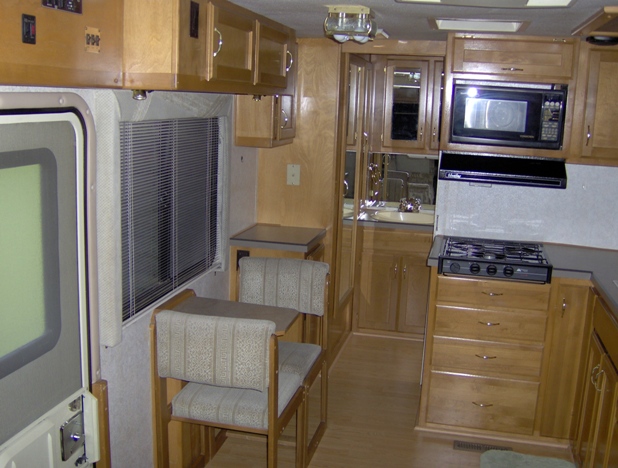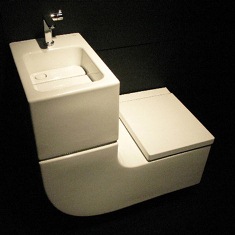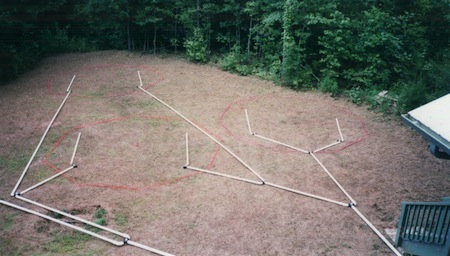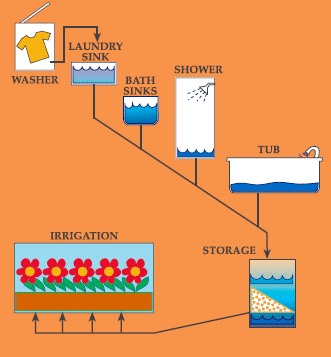 For anyone serious about going off-grid, they really should look into renting an RV for a weekend. Even if one doesn’t go for the dry-camping route & instead hooks up at a full service campground you will quickly learn some interesting items which will apply to your new home. One item that surprises some 1st timers is that there are three water tanks on an RV. Most understand that the clear one holds potable water, the black tank must be for waste, but are left wondering – just what is this grey one for? (not to mention all the gauges…)
For anyone serious about going off-grid, they really should look into renting an RV for a weekend. Even if one doesn’t go for the dry-camping route & instead hooks up at a full service campground you will quickly learn some interesting items which will apply to your new home. One item that surprises some 1st timers is that there are three water tanks on an RV. Most understand that the clear one holds potable water, the black tank must be for waste, but are left wondering – just what is this grey one for? (not to mention all the gauges…)
Grey vs. Black (RV)
The black water tank as alluded to is for waste which is only fed via the toilet. The remainder of the waste lines from the sinks, showers, and even the washing machine (wow, which unit did you rent or buy?) go to a secondary grey water tank. Just like most houses, both tanks on an RV get drained into a central sewage system & hardly are thought of again. I know, but why two tanks, right? Well on an RV there are two main reasons – the first is if you over fill your grey water tank it won’t flood up from the toilet with that associated mess. The second is to aid in the draining of the black water tank & helping to flush the main drain.
Quick Note: If your RV has a washing machine or dishwasher (yes they are out there) you need to be connected to the sewage system with the drain valves / cocks / gates open. Failure to do so… well let’s just say you probably won’t like the results.
Grey vs. Black (Your Home)
In most traditional homes, there is no differentiation made between the two types of waste water and all the drain lines run together & out to the sewer or septic field. This concept or way of doing things though is starting to change as many municipalities are having problems keeping up with the growth, and many areas are being affected by droughts which have also led to many imposing watering restrictions. Some municipalities like Tucson which are affected by both issues have quit simply made it code – all new houses will be built ready for “graywater” use. For many individuals not affected by that as they utilize a septic systems, by diverting the grey water you may be able to utilize a smaller tank, or at least cut down on pumping & other associated issues caused by too much water.
Old School Trick:
Back in Arizona, particularly in the desert regions, one popular item was to ignore the normal drain for the washing machine and to pipe it directly outside (assuming your washing machine wasn’t outside already) where it could help water a few trees or area of grass. I also know of a few people that added to that by doing the same item with their kitchen sinks, which wasn’t too hard to accomplish as they were on an exterior wall. Unfortunately with this system there are a few issues that do arise with just dumping the water on the ground – ponding water breads mosquitos, and attracts animals & pests closer to – if not inside the home, etc…
Handling Grey Water:
After many fits & starts there are now three common ways that grey water is being handled in some homes today; a point of use system, a direct drainage system, and a storage type system. Each of these three systems offers some unique opportunities & challenges depending on your climate.
Point of Use Systems:
 Back in 2008 / 2009 a few new systems sprung up which was the talk of many “greenies” which was a sink integrated with the toilet. The picture above is from ROCA, which is the nicest looking one I can find, but has one serious drawback – the limited amount of water a conscientious person uses while washing, shaving & brushing (EPA WaterSense stats & usage amounts). Based on the stats from the EPA (above) by utilizing a system like this, you might reduce your water usage by 27%. One should also be aware that if you are in California (or a few other places), you may have to put a sign up saying that the water in the toilet is not for drinking… (insert your own punch-line here)
Back in 2008 / 2009 a few new systems sprung up which was the talk of many “greenies” which was a sink integrated with the toilet. The picture above is from ROCA, which is the nicest looking one I can find, but has one serious drawback – the limited amount of water a conscientious person uses while washing, shaving & brushing (EPA WaterSense stats & usage amounts). Based on the stats from the EPA (above) by utilizing a system like this, you might reduce your water usage by 27%. One should also be aware that if you are in California (or a few other places), you may have to put a sign up saying that the water in the toilet is not for drinking… (insert your own punch-line here)
Direct Drainage:
 Unlike the old school method of just let it drain on the ground, there are two main methods allowed today; a separate leaching field (area of gravel buried underground to help dissipate water & let it filter back into aquifers), and one that drains out to feed a garden. I personally don’t like first option as many people put them to close to the house leading to water issues in the house. Now even though it does help replenish the aquifer, many people select this option only to help prevent issues with their septic field, overlooking the ability to accomplish that and do something useful. My friend Allison Bailes of Energy Vanguard shows the second type of system (including the installation), in his case a branched grey water system, which not only accomplishes the good points listed above, but helps reduce water needed for gardens & trees. The catch for this type is not only sizing it properly but in real wet, rainy or frozen areas where the system could potentially freeze or back up. (Picture credit to Allison, which shows part of his installation procedure & the end result)
Unlike the old school method of just let it drain on the ground, there are two main methods allowed today; a separate leaching field (area of gravel buried underground to help dissipate water & let it filter back into aquifers), and one that drains out to feed a garden. I personally don’t like first option as many people put them to close to the house leading to water issues in the house. Now even though it does help replenish the aquifer, many people select this option only to help prevent issues with their septic field, overlooking the ability to accomplish that and do something useful. My friend Allison Bailes of Energy Vanguard shows the second type of system (including the installation), in his case a branched grey water system, which not only accomplishes the good points listed above, but helps reduce water needed for gardens & trees. The catch for this type is not only sizing it properly but in real wet, rainy or frozen areas where the system could potentially freeze or back up. (Picture credit to Allison, which shows part of his installation procedure & the end result)
Storage Type:
 One of the newer types utilizes a storage tank like the first option (only larger) which is generally located outdoors or in a basement. The nicest thing about this type of system is that it can be used to feed water to the gardens, the toilet, or almost anywhere else it is needed. These types of systems are much more complicated and generally involve the use of filters, pumps, finding & using purple pipe for supplies, etc… Speaking of purple pipe, you may also be required to find specially colored sprinkler heads & label outdoor faucets hooked up to this system that the water is not potable. Generally the biggest complaint I do hear about this type of system is the maintenance, though as more manufacturers are getting on board these problems are being eliminated / made easier to deal with. (Picture credit to City Of Tucson)
One of the newer types utilizes a storage tank like the first option (only larger) which is generally located outdoors or in a basement. The nicest thing about this type of system is that it can be used to feed water to the gardens, the toilet, or almost anywhere else it is needed. These types of systems are much more complicated and generally involve the use of filters, pumps, finding & using purple pipe for supplies, etc… Speaking of purple pipe, you may also be required to find specially colored sprinkler heads & label outdoor faucets hooked up to this system that the water is not potable. Generally the biggest complaint I do hear about this type of system is the maintenance, though as more manufacturers are getting on board these problems are being eliminated / made easier to deal with. (Picture credit to City Of Tucson)
Additional Information & Websites:
Gray or Grey? 1 word or two? In all honesty, all 4 versions are used commonly not only in the US but wherever English is spoken. Technically “grAy” is the “American” spelling, whereas “grEy” is the “English” way of spelling it. Personally I bloody don’t care & will generally spell it as grey. As for the one word or two debate, it also doesn’t really matter (even though I prefer it as 1 word), but in the interests of SEO, I went with all 4 versions to cover my bases. With that said, now for some great resources…
- Allison Bailes III, PhD – Energy Vanguard: How to Install a Branched-Drain Greywater System in a Green Home
- City of Tucson: Greywater Main Page with tons of resources
- California 16a Code for greywater via the Greywater Alliance
- UMass: Recycling Gray Water for Home Gardens (Good list of items to consider – slight CYA contradiction in article, but worthy of consideration)
- Paul James – designer of the IrriGRAY graywater product line: 59 page detailed guide on setup, options available including filters, etc…
- New Mexico State University: Safe use of Household Greywater
- Last but not least – don’t forget to check with your local University Cooperative Extension for regulations, issues & best practices in your area

Nice post, Sean. One thing to be aware of with tanks is that if grey water sits untreated for 24 hours, it becomes black water. Also, a lot of the more complex systems with pumps, tanks, and filters are difficult to maintain and abandoned after a relatively short time. Those are a couple of the reasons we chose the branched drain system.
Thanks for including the description of the system I built and installed. Anyone who wants more detail can go to our website and download the proposal we used to get it permitted. There’s a link to it in the article: http://hub.am/iCGFYw.
Thanks for the link Sean,
There does seem to be a perception that pumps / tanks filters are difficult to maintain. Well, if 2 minutes per month is difficult then that would be an issue. Or you could go with the self cleaning filter (exra $$).
One thing to watch with some of the older style gravity systems such as branched drain or laundry to landscape is the very low irrigation efficiency. Branched drain usually result in 80% of the graywater being wasted – but it still feels good?
Just Water Savers USA is a manufacturing company – so you could say we are biased. But then again we don’t sell training courses either – we provide our information, and other related concepts for free. Why? because we live our life around water conservation.
Suggest All Do Their Research
Kind Regards
Paul James
Just Water Savers USA Inc.
My pleasure as it is a great resource & thanks for jumping in also. A big amen Paul to the suggestion that everyone should do their own research.
If I may – I would say that the perception you are fighting is based on reality & while newer equipment might be alleviating those issues (i.e. only requiring 2 minutes a month – assuming you don’t have girls with real long hair) it is one that will take time & knowledge to overcome. I do welcome guest articles, so if you would like to cover this topic in more depth I would be more than willing to take a look at it.
Landscape / irrigation efficiency numbers – sorry but I’m not buying that one at all. Where exactly is the waste? Is it evaporating – no? Is it running into the street – no? It is being soaked up into the soil which has its own little eco-system that also needs water to thrive. A thriving & healthy soil system results
in healthier plants not just in that area but also further out (i.e. root systems spread far & wide)
Even if X% of the water was never needed & kept on soaking deeper & deeper into the ground it still ends up in the aquifers which supplies the water needed for the cycle to continue. Personally I rather see it there, then overloading the sewer systems.
Thanks again & best of luck
Nice post, Sean. One thing to be aware of with tanks is that if grey water sits untreated for 24 hours, it becomes black water. Also, a lot of the more complex systems with pumps, tanks, and filters are difficult to maintain and abandoned after a relatively short time. Those are a couple of the reasons we chose the branched drain system.
Thanks for including the description of the system I built and installed. Anyone who wants more detail can go to our website and download the proposal we used to get it permitted. There’s a link to it in the article: http://hub.am/iCGFYw.
Thanks for the link Sean,
There does seem to be a perception that pumps / tanks filters are difficult to maintain. Well, if 2 minutes per month is difficult then that would be an issue. Or you could go with the self cleaning filter (exra $$).
One thing to watch with some of the older style gravity systems such as branched drain or laundry to landscape is the very low irrigation efficiency. Branched drain usually result in 80% of the graywater being wasted – but it still feels good?
Just Water Savers USA is a manufacturing company – so you could say we are biased. But then again we don’t sell training courses either – we provide our information, and other related concepts for free. Why? because we live our life around water conservation.
Suggest All Do Their Research
Kind Regards
Paul James
Just Water Savers USA Inc.
My pleasure as it is a great resource & thanks for jumping in also. A big amen Paul to the suggestion that everyone should do their own research.
If I may – I would say that the perception you are fighting is based on reality & while newer equipment might be alleviating those issues (i.e. only requiring 2 minutes a month – assuming you don’t have girls with real long hair) it is one that will take time & knowledge to overcome. I do welcome guest articles, so if you would like to cover this topic in more depth I would be more than willing to take a look at it.
Landscape / irrigation efficiency numbers – sorry but I’m not buying that one at all. Where exactly is the waste? Is it evaporating – no? Is it running into the street – no? It is being soaked up into the soil which has its own little eco-system that also needs water to thrive. A thriving & healthy soil system results
in healthier plants not just in that area but also further out (i.e. root systems spread far & wide)
Even if X% of the water was never needed & kept on soaking deeper & deeper into the ground it still ends up in the aquifers which supplies the water needed for the cycle to continue. Personally I rather see it there, then overloading the sewer systems.
Thanks again & best of luck
My pleasure as it is a great resource & thanks for jumping in also. A big amen Paul to the suggestion that everyone should do their own research.
If I may – I would say that the perception you are fighting is based on reality & while newer equipment might be alleviating those issues (i.e. only requiring 2 minutes a month – assuming you don’t have girls with real long hair) it is one that will take time & knowledge to overcome. I do welcome guest articles, so if you would like to cover this topic in more depth I would be more than willing to take a look at it.
Landscape / irrigation efficiency numbers – sorry but I’m not buying that one at all. Where exactly is the waste? Is it evaporating – no? Is it running into the street – no? It is being soaked up into the soil which has its own little eco-system that also needs water to thrive. A thriving & healthy soil system results
in healthier plants not just in that area but also further out (i.e. root systems spread far & wide)
Even if X% of the water was never needed & kept on soaking deeper & deeper into the ground it still ends up in the aquifers which supplies the water needed for the cycle to continue. Personally I rather see it there, then overloading the sewer systems.
Thanks again & best of luck